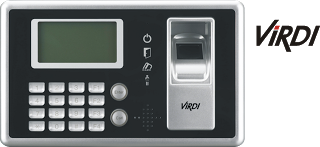While Mr Giger perhaps paints rather a bleak picture of this relationship, depicting it as cold and even dangerous, there is something very positive about marrying biology and technology, namely its benefits to security.
This is most evident in the division of access control known as biometrics, being the identification of humans by their characteristics or traits. Biometric authentication has (quite literally, in some instances) opened many doors for those within the security industry by providing arguably the only means of controlling access that cannot be copied, cloned or circumvented in any way. It does this by using the human body itself as access tag.
One major benefit of incorporating biometrics, and fingerprint authentication in particular, into your security infrastructure is that the access device (being the finger) cannot be misplaced or stolen as is often the case with loose tags. Authentication occurs by placing a finger onto a small glass “window” on the reader, which then scans it and matches it to the records stored in memory, granting access based on whether or not a record is found.
CENTURION is an authorised distributor of the award-winning Virdi range of biometric readers. Virdi uses state-of-the-art fingerprint recognition and RFID technology to provide an access control system boasting superior functionality as well as dependability.

Some of the advanced features you can look forward to with the Virdi range are:
- Live and Fake Finger Detection
A patented three tiered approach incorporating IR scanning technology with the ability to identify the material the fingerprint is made of (chemical composition) such as silicon, rubber, paper, gel, etc. A capacitive sensor is built into the optical scanner and an intelligent algorithm is used to measure and compare image distortion.
- Patented Search Algorithm
Incredibly fast and accurate template matching algorithm will compare a 1:1 match in less than half a second, and a 1:N match for 1000 users in less than 1 second.
- Number of Enrolled Fingers Set by User
Each user can load between 1 and 5 fingerprints on the biometric terminal. The database can accommodate the enrolment of up to 10 fingers and can be set to check that similar fingers do not exist in the database thereby eliminating “ghost employees”.
- Registration and Authentication Levels Set by User
Each user can be enrolled and thereafter verified using custom registration and verification levels which have been individually configured to match the conditions of their fingers and the security needs of the organisation.
- Transaction Options Set by User
Each user can have their transaction methods individually assigned; i.e. finger only, pin and finger, card or finger, card and finger, template on a card, etc. There are over 10 combinations.
- Push technology
In order to minimise network traffic and provide real-time update of transactions, the devices will “push” their transactions to the server as they occur. While templates are being sent to the Virdi devices, users can continue to transact.
- Optical Sensor (Patented)
The optical sensor has a patent on the angle of the prism which gives the optimal level of distortion for image capture. This means that the biometric image scanned on a Virdi Optical Sensor has a higher image quality than competitive products; furthermore the surface of the sensor is hardened and coated which makes it resistant to wear and tear including use in harsh environments. This has been field proven in a multitude of installation in Africa where some of the harshest environments exit and where abuse of technology is rife.
- Interfaces
The Virdi Biometric Terminals are intelligent and available with a multitude of communication and interface ports. As standard they have TCP/IP for template and data management, Wiegand 26 and 34 bit In and Out ports to connect third party RFID readers or connect to access control controllers, onboard relays with normally-open/normally-closed terminals and motorised lock control, door status monitor, alarm panel I/F and RS232/485 ports.
- Applications
The Virdi Biometric Terminals can either operate as standalone or networked/server managed devices and incorporate the functionality required for Time and Access management and Canteen Control. Alternatively, they can simply emulate a card reader for interfaces to legacy systems.





